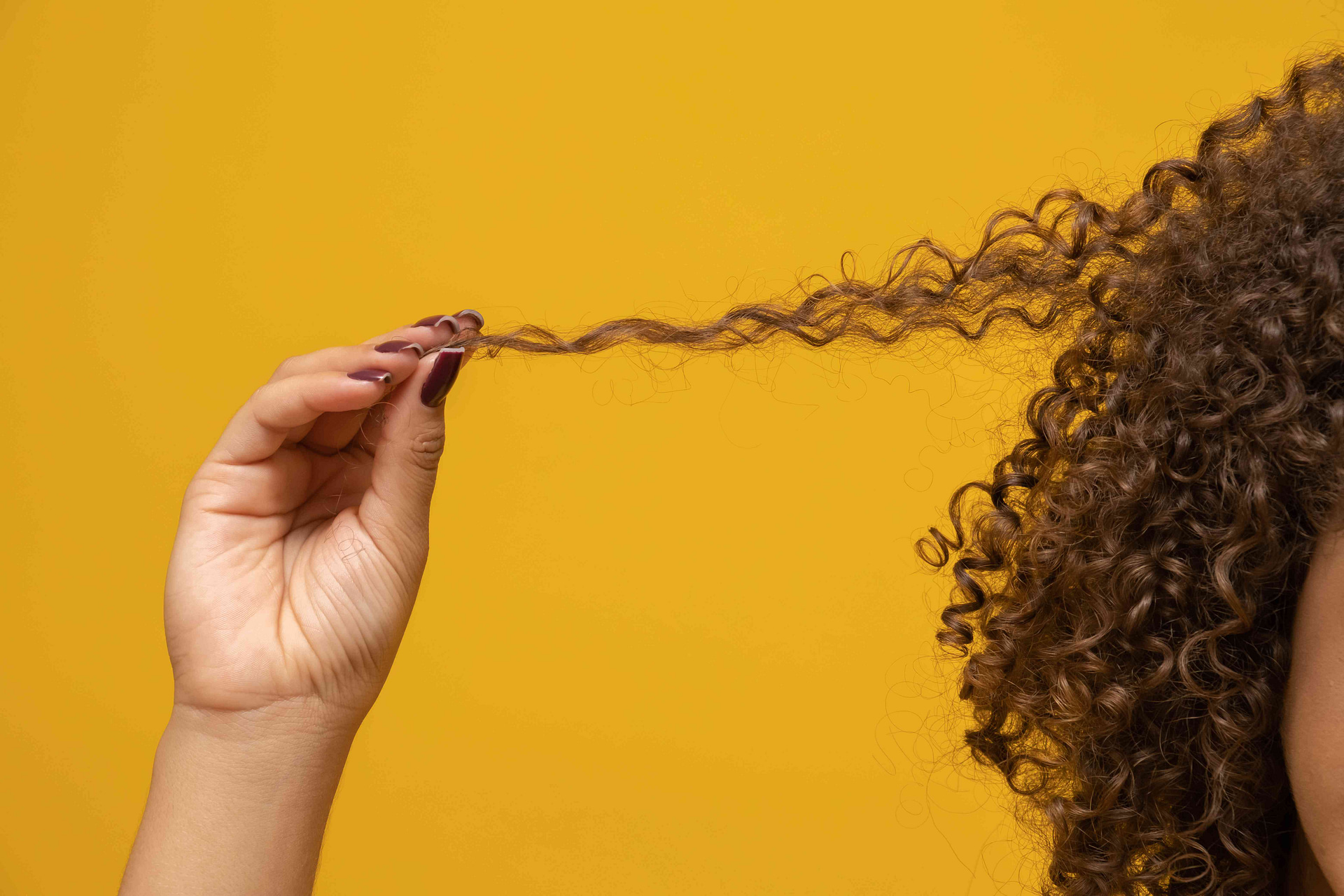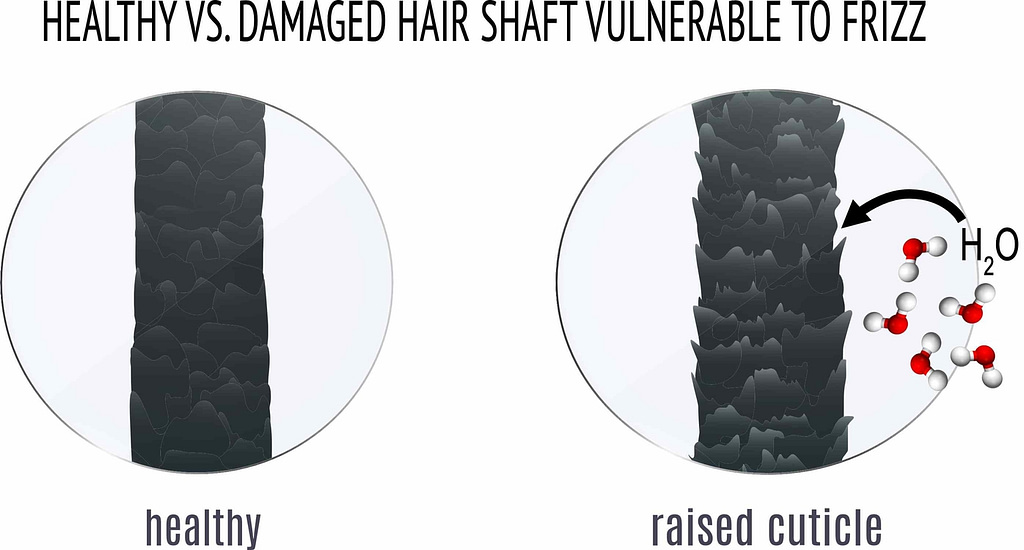
Are you troubled by hair frizz? If so, you are not alone. According to one survey in the United States, 95% of women say frizz is an issue for them. In another survey conducted in the United Kingdom, 60% said they suffered from the frizzies. Regardless of which is more accurate, it’s more than likely that you suffer from frizz-related bad hair days. While genetics plays a role in how prone you are to frizzy hair (people with coarse, curly and wavy hair are more prone to frizz than people with fine and straight hair) there is a lot you can do to avoid and limit the undesirable effects of frizz.
Hair frizz results from multiple factors impacting the hair shaft. Every day your hair is under assault by: chemical forces, mechanical forces, even UV radiation! The amount of hair frizz you get is determined by everything from your daily activities including exercise choices and hair styling techniques to the climate you live in. However, the root cause of frizz all comes down to the hair cuticle. If you were to look at your hair shaft under a microscope you would see layers of shingle-like structures overlaying one another. Frizz is caused when those shingles are disrupted and no longer lay flat down on top of each other. The gaps caused by this disruption allow for moisture ingress that cause the shaft to swell and displace itself from the rest of your hair. After water gets into your hair shaft it starts swelling causing internal stresses that twist the hair shafts and drives hair out in multiple directions.

can penetrate the hair shaft.
Fundamentally, beating hair frizz comes down to minimizing the mechanical, chemical and Ultra-violet (UV) disruptions to the hair shaft and its cuticle. As a result, unsurprisingly, beating hair frizz often comes simply down to adjusting your daily habits a bit to give your hair just a little more TLC… tender loving care.
Tip #1 for Beating Hair Frizz – Minimize Mechanical Damage
Avoid mechanical disruption to your hair by minimizing the force and friction you apply to your hair, especially after washing. In particular, use a wide-tooth comb to detangle and if you must towel dry, use a micro-fiber towel instead of a cotton one to gently pat your hair dry. According to celebrity stylist Mark Townsend, those tiny loops in a traditional terry cloth towel can hook onto hair cuticles and lift them up from the shaft.
Tip #2 – Avoid Unnecessary Chemical Exposure
Steer clear from chemical disruptions by avoiding too much bleaching and washing of your hair, also minimize chlorine exposure. If you’re in the pool a lot, wear a swimming cap, or if you don’t like doing that, rinse your hair with fresh water both before and after you enter the pool. Rinsing before means fresh water will be absorbed into that shaft in advance so less chlorine can get in while you’re swimming.
Tip #3 – Minimize Thermal and UV Damage
Heat from tools can disrupt the cuticle and even boil water retained in the shaft, causing bubbles to form inside the hair fiber. Not only does that damage the structural integrity of your hair but it also imparts stresses that twist hair in different directions leading to frizz. As a result, air dry your hair whenever you can. If you need to use tools, attach a diffuser when you blow dry and limit styling tools temperature to no higher than 400°F (204°C). Whatever you do, don’t apply heat tools to wet hair as that can cause the boiling problem described above. Award-winning international hair stylist Anthony Nader even recommends rinsing your hair in cold water because, “it closes the cuticle, imparting shine and manageability.”
Similarly, wear a hat when you are outside to protect your hair from the sun’s rays. UV radiation can embrittle hair and damage the scalp, stunting production of new hair cuticles.
Tip #4 – Maintain Your Hair’s Natural Oils
Sebum is the name of the natural oil produced by the sebaceous glands in our scalp that provide direct hair health support. Sebum has natural antiseptic and protective qualities that coat the cuticle and provide shine. Over-washing and harsh shampoos can strip hair of its natural protective oil layer. So be conscious of your hair’s natural oil and preserve it as best you can. Stylist Giovanni Vaccaro even recommends using a boar bristle hairbrush that carries sebum from the scalp down the hair strand “removing frizz along the way.”
Tip #5 – Use a Paraben Free, Sulfate Free Leave-in Conditioner with Natural Oils
No matter how much we want to preserve our natural sebum few of us want to go around too long without a nice hair wash. As a result, inevitably amounts of sebum get stripped away and need to be replaced. To counter that phenomena it is important to use a leave-in conditioner. With a leave-in product its especially important for it to be paraben free and sulfate free. We recommend using a light-weight leave-in conditioner that uses natural oils with protective qualities similar to sebum and vitamin nutrition to support the follicle and reduce hair loss.
Desert Botanicals SonoranShine™ Featherweight Conditioner is especially formulated to balance moisture enhancing natural desert cactus and nut oils with protective high-tech silicones specifically engineered for hair protection and enhancement. Sonoranshine’s proprietary blend of oils with Aloe Vera protects cell barriers and prevents dryness thereby adding strength and vitality to the shaft while filling the gaps of uplifted cuticles. Each oil was selected and added in ratios to maximize hair cuticle protection without making hair heavy or greasy. In addition it contains silk amino acids which have excellent moisture binding abilities. Silk aminos are known to penetrate into the upper layers of the skin and through the hair cuticle into the hair shaft resulting in improved flexibility and manageability of the hair leaving a soft and natural look. Finally, panthenol (provitamin B5) and vitamin E are included to add shine, strength, and to slow hair loss.
For more information or to purchase SonoranShine™ Featherweight Hair Glosser visit: click here.
References:
Abigail Whittington, “8 Pro Secrets to Tame Frizz,” Good Housekeeping, Vol. 270 Issue 5.
Holly Fisher, “New Hair’s Resolutions,” Girls’ Life, Dec.2019/Jan.2020 Vol. 26 Issue 3.
Hannah Morrill, “Fighting Frizz,” Allure, August 2012, Vol. 22 Issue 8.
HealthyHairPlus.com, “Can UV Light Damage Your Hair”
Liz Krieger, “Banish Frizz Forever,” Harper’s Bazaar, June 2015, Issue 3634.
Shonagh Walker, “Australian Women’s Weekly,” February 2010, Vol. 8 Issue 2.
Yanar Alkayat, “Great hair–EVERY DAY!” Health & Fitness Magazine, Dec. 2013
Great info! I hope you will make a shampoo and conditioner, too. Thanks.
Useful tips for me. I hope that, keep my hair healthy using your tips. Thanks for sharing..
Thanks for sharing